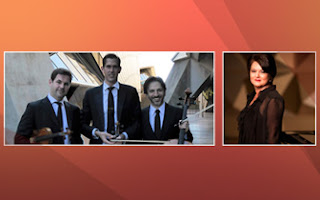At a time when the daily news seems to be increasingly
bizarre or distressing, it was a great comfort to enter the world of Kathryn
Selby and her colleagues and have equilibrium restored in an exceptional
concert – the final for the year. Andrew Haveron, Violin, Tobias Breider, Viola
and Umberto Clerici, Cello joined forces with Selby to perform a richly contrasting
program of works by Turina, Mozart and Dvořák. This was chamber music as it should be: a lively exchange of
musical ideas and creative energy; each musician contributing their unique
voice and yet utterly responsive to the balance required to maintain the unified
ensemble.
It’s hard to fathom
why Mozart’s Piano Quartet No. 1in G minor, K.478 met with such a cool
reception when it was first published in 1785. To 21st century ears
the work is thrilling, with the piano working as hard as the strings to
contribute an independent voice as well as offering sympathetic and sophisticated
accompaniment. Breider’s phrasing with the viola was particularly communicative
in the Allegro ensuring that this
important voice was heard, and the piano passages with their complex interweaving
in relation to the strings showed off Mozart’s compositional skill to great
effect. The subtle string syncopation in the Andante provided another moment to admire the composer’s gift of
delicate variation.
Joaquín Turina’s Piano Quartet in A
minor brought the creative tumult of the 1930s to life. The Lento – Andante mosso played in unison
by the strings opened with a sultry theme taken up by piano and cello. There was
a dramatic restlessness in the unfolding thematic material throughout the Andante mosso, as the emotional flavor of
the music shifted from reflective to almost violent, tossed between the
instruments. While the Vivo continued
to contrast contemplative and lively material, the mood was more playful with
the strings offering precision pizzicato passages and resounding bass chords
from Clerici’s cello. Broader string phrasing and more expansive piano chords
accentuated the physicality of the final Andante-Allegretto
movements as the ensemble created an impressionist atmosphere haunted by romantic
Spanish thematic echoes.
There is a
particular magic that transforms a performance when each musician in an
ensemble really wants a work to reach
the most perfect standard possible, and this occurred in the performance of Dvořák’s
Piano Quartet No, 2 in E flat major, Op. 87. As we heard in the Mozart quartet,
the skill of the musicians animated Dvořák’s consummate compositional craftsmanship.
The Allegro
con fuoco opened with robust energy, punctuated by the striking dynamic
contrasts. Clerici’s cello solo introduced the exquisite Lento movement, so moving in the mood of tranquility sustained by
each instrument. What began as a seemingly uncomplicated waltz in the third
movement was developed to reveal the traditional essence of the source melodies
and the idea of dancing continued in the Finale.
Allegro, non troppo. Haveron really shone in this work, leading the
string ensemble in communion with the piano. The infinite colorations described
in the variety of bowing and changing rhythmic emphases made the work live and
breathe.
With such a musical gift as this final Selby and Friends
concert for 2017, it seems that Christmas has come early!

